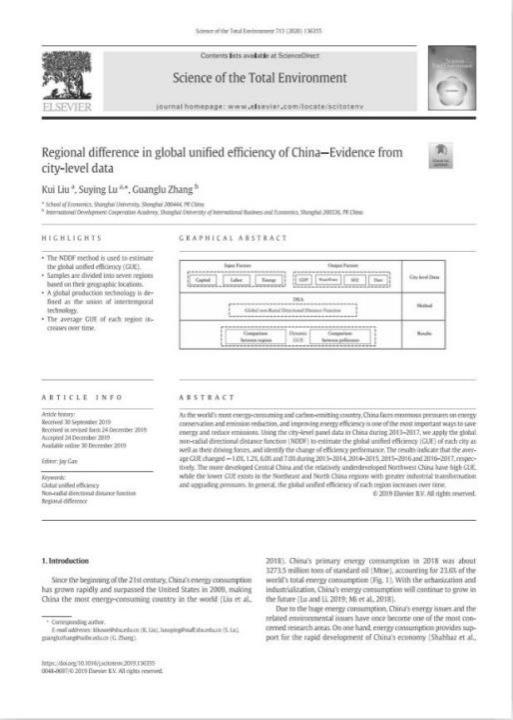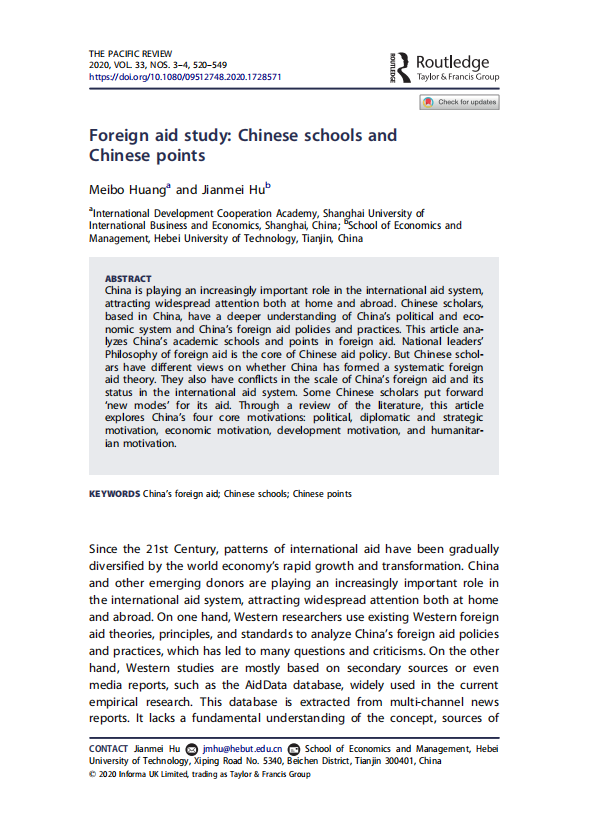2020上半年度国际经贸研究所研究人员共发表论文14篇,其中国内A级期刊论文2篇,B1级论文1篇,B2级论文2篇,一般C刊1篇,北大中文核心期刊1篇,其他论文3篇。


2020上半年度国际经贸研究所发表的学术论文
作者 | 论文题目 | 期刊名 | 发表 刊期 | 页码 | 期刊 等级 |
铁 瑛 蒙英华 | 移民网络、国际贸易与区域贸易协定 | 经济研究 | 2020(02) | 165-180 | A |
刘啟仁 铁瑛(通讯作者) | 企业雇佣结构、中间投入与出口产品质量变动之谜 | 管理世界 | 2020(03) | 1-23 | A |
Meibo Huang Jianmei Hu | Foreign aid study: Chinese schools and Chinese points, | The Pacific Review(SCI) | Vol. 33, No. 3-4 | 520-549 | |
Kui Liu Suying Lu Guanglu Zhang | Regional difference in global unified efficiency of China—Evidence from city-level data | Science of the Total Environment(SCI) | 2020(713) |
| |
Xiaoli Tai Xiao Wu Yuxuan Tang | A quantitative assessment of vulnerability using social-economic-natural compound ecosystem framework in coal mining cities | Journal of Cleaner Production(SCI) | 2020(258) |
| |
Mingchao Yu Ran Yu Yuxuan Tang Zhen Liu | Empirical study on the impact of China's metro services on urban transportation energy consumption | Research in Transportation Economics | 2020(80) |
| |
阎虹戎 刘灿雷 | 外商引资政策、精准导向与中国制造业升级 | 国际贸易问题 | 2020(06) | 39-55 | B1 |
王 钊 | 中国的基础设施建设援助与国际发展援助的“共生”:援助国产业结构差异的视角 | 外交评论 | 2020(02) | 51-81 | B2 |
黄梅波 张晓倩 邓 昆 | 非洲国家的债务可持续性及其对策分析 | 国际经济评论 | 2020(04) | 84-97 | B2 |
阎虹戎 张小鹿 黄梅波 | 互利共赢:中国对外援助与受援国出口能力提升 | 世界经济研究 | 2020(03) | 95-106+137 | C |
阎虹戎 黄梅波 | 中非投资合作及其影响——上海对外经贸大学“2019中非经贸论坛”综述 | 国际经济合作 | 2020(1) | 152-159 | 北大中文核心期刊 |
崔文星 黄梅波 | 中国对非洲发展援助与国家利益分析 | 《全球治理的新动力与新机制》,上海人民出版社 | 2020 | 8-22 | 一般 |
Lu Jiang Zetao Wu | Public-Private Partnership Toward More Effective International Development Cooperation | China Quarterly of International Strategic Studies | Vol. 5, No. 4 | 1–23 | 一般 |
黄梅波 王晓阳 | 非洲港口市场竞争环境及中非港口合作 | 开发性金融研究 | 2020(06) | 1-15 | 一般 |
铁瑛、蒙英华,“移民网络、国际贸易与区域贸易协定”,经济研究,2020年第2期
摘要:本文从移民网络的角度探讨了区域贸易协定(FTA)缔结的动因问题,提出并证明了“移民网络促进FTA缔结”这一假说,并发现移民网络因素的加入可以将既有FTA缔结动因相关研究的模型预测准确率提升约4%,具有重要的意义。进一步的机制检验发现,移民网络主要通过促进双边贸易流来提升两国FTA的签订概率,表现为“移民网络—国际贸易—FTA缔结”这一核心发生机制。本文拓展性的细化研究还发现,无论从时间趋势或FTA缔结数量而言,移民网络对FTA缔结所起到的促进作用都呈现出边际递减规律;“移民网络—国际贸易—FTA缔结”机制在“南-北”国家对组合中会得到增强,但在“北-北”国家对组合中的表现相对较弱。本文的结论意味着,移民网络是发展中国家参与区域经济合作的重要资源,在当前贸易自由化多边进程受阻、逆全球化思潮涌动、国际秩序和规则面临重塑的背景下,充分发挥和利用“移民红利”,对我国FTA战略的推进及世界FTA领域“中国范本”的探索有重要意义。
刘啟仁、铁瑛(通讯作者),“企业雇佣结构、中间投入与出口产品质量变动之谜”,管理世界,2020年第3期
摘要:近年来,尽管中国企业雇佣大学生的比例在增长,但出口产品质量却没有发生显著地提升,形成了所谓的出口产品“质量变动之谜”。本文将企业异质“雇佣结构”引入Hallak & Sivadasan(2013)模型,探讨劳动投入与出口产品质量之间的关系,并试图结合企业技能投入和中间品投入质量的互补性对“质量变动之谜”进行解释。利用经济普查、工业企业和海关匹配数据进行实证检验,结果发现:(1)雇佣结构升级对出口产品质量起到正向促进作用;(2)雇佣结构与企业中间品投入质量具有互补性,中间品质量越高,雇佣结构对出口产品质量的促进作用越强;(3)现实所观察到的出口产品“质量变动之谜”部分源于进口中间品占比的大量下降所导致的中间品投入质量的下降,雇佣结构升级对质量的提升作用受到了中间品质量下降的拖累,未能充分地发挥出其应有的质量升级效应。总之,在“贸易大国迈向贸易强国”的攻坚期,虽然高学历劳动力供给的增长有助于中国产品质量的提升,但这一过程亟需匹配相应高质量的中间产品投入。因此,进一步推进中间品贸易自由化和国内中间品供给能力是破解质量升级难题的重要手段。
Meibo Huang & Jianmei Hu,“Foreign aid study: Chinese schools and Chinese points”,The Pacific Review,DOI:10.1080/09512748.2020.1728571 ,Feb 2020
ABSTRACT: China is playing an increasingly important role in the international aid system, attracting widespread attention both at home and abroad. Chinese scholars, based in China, have a deeper understanding of China’s political and economic system and China’s foreign aid policies and practices. This article analyzes China’s academic schools and points in foreign aid. National leaders’ Philosophy of foreign aid is the core of Chinese aid policy. But Chinese scholars have different views on whether China has formed a systematic foreign aid theory. They also have conflicts in the scale of China’s foreign aid and its status in the international aid system. Some Chinese scholars put forward ‘new modes’ for its aid. Through a review of the literature, this article explores China’s four core motivations: political, diplomatic and strategic motivation, economic motivation, development motivation, and humanitarian motivation.
Kui Liu,Suying Lu&Guanglu Zhang,“Regional difference in global unified efficiency of China—Evidence from city-level data”, Science of the Total Environment,2020(713)
Abstract: As the world's most energy-consuming and carbon-emitting country, China faces enormous pressures on energy conservation and emission reduction, and improving energy efficiency is one of the most important ways to save energy and reduce emissions. Using the city-level panel data in China during 2013–2017, we apply the global non-radial directional distance function (NDDF) to estimate the global unified efficiency (GUE) of each city as well as their driving forces, and identify the change of efficiency performance. The results indicate that the average GUE changed−1.0%, 1.2%, 6.0% and 7.0% during 2013–2014, 2014–2015, 2015–2016 and 2016–2017, respectively. The more developed Central China and the relatively underdeveloped Northwest China have high GUE, while the lower GUE exists in the Northeast and North China regions with greater industrial transformation and upgrading pressures. In general, the global unified efficiency of each region increases over time.
Xiaoli Tai, Wu Xiao & Yuxuan Tang, “A quantitative assessment of vulnerability using social-economic-natural compound ecosystem framework in coal mining cities”,Journal of Cleaner Production,2020(258)
ABSTRACT: Coal resources play an important role in socioeconomic development around the world. Yet the development driven by coal mining is accompanied by ecological damage, social instability, and economic vulnerability, which seriously hinder the sustainable development of coal mining cities. It is, thus, urgent to realize the sustainable development of coal mining cities, premised on comprehensive and scientific analysis of these cities’ vulnerability characteristics. In this study, based on the analysis of the social-economic-natural compound ecosystem (SENCE), we constructed a vulnerability evaluation indicator system (28 indicators) for coal mining cities. Took cities producing more than ten million ton of coal in China in 2015 as examples, the weight of every indicator was obtained using entropy weight method. In addition, cities were ranked and classified based on vulnerability characteristics of three subsystems. Our findings suggest that preventing soil erosion, accelerating the resolution of historical problems, promoting green mining, and encouraging renewable energy should be adopted to reduce natural vulnerability; resettling the unemployed and adjusting employment structure are effective in enhancing the sustainability of social subsystems; changing industrial structure, encouraging self-employment, as well as implementing scientific and technological innovation should be considered to realize economic sustainability.
Mingchao Yu, Ran Yu, Yuxuan Tang & Zhen Liu,“Empirical study on the impact of China's metro services on urban transportation energy consumption”,Research in Transportation Economics,2020(80)
ABSTRACT: The development of metro systems has shortened the travel distances and density within cities, and promoted the transformation of urban transportation, which has had an impact on traffic energy consumption. Based on data from 81 cities in mainland China with a permanent population of more than one million from 2003 to 2016, this paper uses the difference in differences (DID) method to study the impact of urban metro systems on transportation energy consumption in China. The results show that after the opening of the city subway, per capita traffic energy consumption decreased, indicating that subways reduce energy consumption in urban areas; there exists a “U” relationship between metro operation intensity and per capita traffic energy consumption. The average level is far from the inflection point value, which indicates that an increase in metro operation intensity has the effect of improving traffic energy consumption. However, the marginal benefit of reducing urban traffic energy consumption is gradually decreasing. Further research has found that the metro system can reduce the distance travelled by cars by replacing the use of traditional automobile transportation, thus reducing transportation energy consumption.
阎虹戎、刘灿雷,“外商引资政策、精准导向与中国制造业升级”,国际贸易问题,2020年第6期
摘要:利用外资是中国构建开放型经济新体制的重要内容,在目前经济增长转型时期,如何积极有效地利用外资推动经济高质量发展是当前面临的重要任务。在此背景下,本文利用中国大量微观企业数据和外商引资政策中的《外商投资产业指导目录》,从引资政策精准导向的视角,采用双重差分法评估了其对制造业产业升级的政策效应,有效控制了计量模型中可能存在的内生性问题。研究发现,外商引资政策通过《产业指导目录》的精准导向,对中国制造业产业升级具有积极的促进作用,且在考虑了识别假设条件和其他稳健性检验之后仍然成立。进一步检验发现,外商引资政策对制造业产业升级的促进作用,主要通过企业间的资源再配置和要素配置效率的提升所致,研发创新驱动的产业升级渠道并未起作用,且这一政策效应主要作用在资本密集度、国企占比和市场化程度均较低的城市以及中西部地区。因此,在目前《外商投资准入负面清单》的管理模式下,采用《鼓励外商投资产业目录》等方式持续优化外商投资导向仍具有积极的政策含义。
王钊,“中国的基础设施建设援助与国际发展援助的‘共生’——援助国产业结构差异的视角”,外交评论,2020年第2期
摘要:发展与援助在二战后的制度化结合是现代援助体系诞生的标志,对外援助的道德属性被框定为帮助受援国实现发展。但在现实中,西方和中国常质疑彼此的援助道德动机,前者认为后者的基建援助是“新殖民主义”、“债务陷阱”,后者认为前者的软性援助人员费过高、口惠实不至、干涉他国内政。本文尝试在国际政治经济学框架下,将对外援助决策的规范建构与理性选择双重属性理论化,发掘一国产业结构与对外援助政策间的关联性,以解释西方与中国对外援助的特征差异和误解来源。即发展通过中间变量——产业结构分解出发展理念、发展资源和发展压力等作用机制,影响了一国对外援助的部门分配,工业国倾向基础设施与生产性援助,第三产业国则偏好投放专业服务类援助。在全球价值链分工视野下,中国对外援助的偏好和结构具备合理性和正当性,不同援助方的发展援助既会产生竞争,也可互补共生,进而更好地推动2030愿景和新型全球治理实现。
黄梅波、张晓倩、邓 昆,“非洲国家的债务可持续性及其对策分析”,国际经济评论,2020年第4期
摘要:近年来,国际市场不景气、全球贸易紧张局势升级扩大、本国货币大幅贬值等一系列不利冲击,导致非洲大多数国家债务风险陡升,债务可持续性面临较大挑战,爆发债务危机的可能性大大上升。为防止债务危机发生,非洲国家与国际社会需要共同努力。从非洲国家来说,长期应积极调整产业结构,大力发展国内债务市场,提高经济抗击外部冲击的能力;短期应调整财税政策,加强债务管理,以降低债务风险,维持债务的可持续性。作为非洲国家的债权国之一,面对非洲债务风险的上升,中国应在继续支持非洲各国基础设施建设和经济发展的基础上,优化现行债权结构,谨慎借贷,贷前开展严格的可行性分析,确保项目的经济社会环境的可行性及借款国的贷款偿还能力,同时敦促债务国加强债务管理,防止债务违约的发生。
阎虹戎、张小鹿、黄梅波,“互利共赢:中国对外援助与受援国出口能力提升”,世界经济研究,2020年第3期
摘要:本文利用2002-2014年中国对120个国家提供的援助与受援国出口数据,研究了中国对外援助对受援国对华出口能力提升的影响。研究表明:中国对外援助促进了受援国对华出口规模扩大,提高了受援国对华出口能力,这对于提高受援国自主发展能力和满足国内消费需求来说都是有利的,符合中国对外援助“互利共赢”的基本原则。异质性检验发现:中国对外援助促进了符合受援国比较优势的制造业产品,尤其是中低端制造业产品对华出口能力提升,并未促进农产品等非制造业产品以及初级品和资源品等制造业产品对华出口能力的提升,从而较为全面地驳斥了西方国家提出的“资源掠夺论”等负面观点;中国对外援助不仅促进了非洲国家对华出口能力提升,也促进了非洲以外其他受援国对华出口能力提升,尤其是中低收入受援国对华出口能力提升;中国“促贸援助”并未显著促进受援国对华出口能力提升。作用机制检验发现,受援国工业发展在中国对外援助促进受援国对华出口能力提升方面起到了部分中介效应。
阎虹戎、黄梅波,“中非投资合作及其影响——上海对外经贸大学‘2019中非经贸论坛’综述”,国际经济合作,2020年第1期
摘要:由上海对外经贸大学主办的“2019中非经贸论坛”于2019年11月15日在上海举行,本届论坛的主题是“中非投资合作及其影响”。一百余位来自高校和研究机构的知名专家和学者出席会议,从经济学视角对中非经贸合作特别是中非投资合作中的机遇、挑战及其对中国和非洲国家的影响,以及中非经贸合作如何与“一带一路”倡议对接等问题进行了深入探讨,内容涉及中非投资合作的战略、中国对非援助与贸易、中国对非投资与产能合作、非洲国家债务可持续性等多个方面,论坛的举办对于促进非洲经济发展及深化中非经贸合作关系具有重要意义。
崔文星、黄梅波,“中国对非洲发展援助与国家利益分析”,载《全球治理的新动力与新机制》,上海人民出版社,2020
内容提要:近年来,中国对非援助常常在国内引发争论。其中的一个重要观点是,中国在自身尚有众多贫困人口的情况下为什么还要把钱送给遥远大陆上的外国人。本文尝试对此问题进行回答。本文在对国家利益以及国际发展援助的动机进行分析的基础上,对中国对非发展援助的动机及其与国家利益的关系进行了深入阐释。论文首先对中国在计划经济时期对非援助的政治利益进行考察。其次,则分析了改革开放时期中国与非洲之间互利双赢的发展合作伙伴关系,援助对发展这一伙伴关系的重要作用。在新时代,中非发展合作的成功经验将会增强中国在全球发展治理中的话语权与影响力。总起来看,一方面,中国对非发展援助与中国的国家利益是密切相关的。另一方面,中国的对外援助又超越了简单的国家利益,而成为构建人类命运共同体的重要实践。
Lu Jiang &Zetao Wu,“Public-Private Partnership Toward More Effective International Development Cooperation”,China Quarterly of International Strategic Studies,2020(05)
Abstract: Since the new millennium, several shifts in international development cooperation have brought a series of challenges to the traditional ODA model, typically adopted by the OECD-DAC members. The ‘development cooperation public-private-partnership’, featuring incorporation of private sector actors and business models into development cooperation, is an important driving force. This article aims to examine the origin, concept and mechanism of the new model of ‘development PPP’, and discuss some main problems that have already occurred or will likely occur in practice. It also compares the Northern ‘development PPP’ model with the Chinese ‘development package’ model and see how likely for the two to learn from each other. It is argued that, the inclusion of non-governmental actors, especially that of private sector, has become an irresistible trend in global development cooperation and China has been a pioneer in this regard. Having that said, China needs to further systematize and theorize its rich practices of ‘development package’, and establish relevant agencies and carry out more concrete and practical policy measures to boost PPP and combine commerce with aid in delivering development cooperation. This will pave the way for the further development of the ‘package’ model, and help form effective dialogue with its Northern counterparts. In this process, China needs to take full consideration of its specialty as a developing country from global south and make further efforts trying to reshape and lead the discourse in the global development cooperation arena.
黄梅波、王晓阳,“非洲港口市场竞争环境及中非港口合作”,开发性金融研究,2020年第6期
摘要:随着中国经济的快速崛起以及参与世界贸易体系程度的不断加深,中国与世界各国和地区之间的政治、经济交往日益密切。2000年中非合作论坛的开启,使中国与非洲大陆各个国家在经济、贸易等方面的关系逐渐升温。2019年中国已经连续十年成为非洲第一大贸易伙伴国。作为联系中非贸易的枢纽桥梁,海上交通航线的发展受到了广泛的关注。港口作为海上贸易过程的关键一环,中非港口合作的进展和效果对于推进两地区间贸易,推进“一带一路”的建设具有重要指导作用。本文着重分析了非洲港口市场的现状和竞争环境,以及中非港口的交流与合作的现状,分析中国参与非洲港口市场存在的有利和不利因素,并对未来中非港口合作的有效推进提出政策建议。

